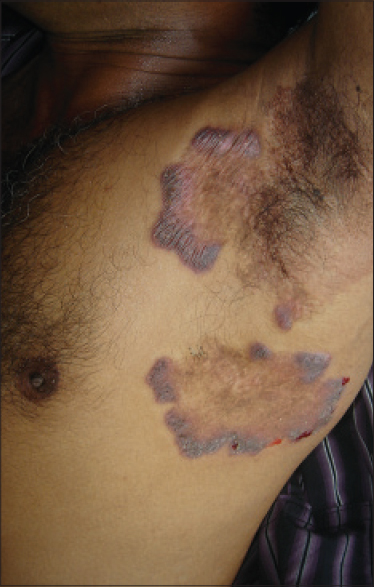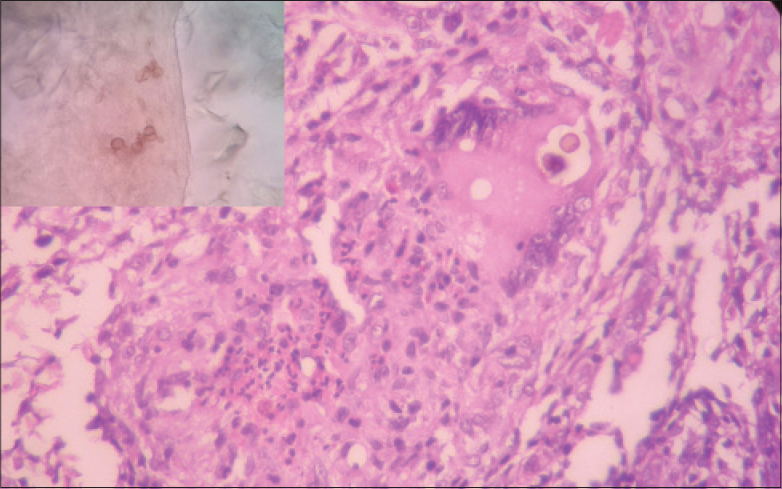Translate this page into:
Two cases of axillary chromoblastomycosis
2 Department of Microbiology, Yenepoya Medical College, Yenepoya University, Mangalore, Karnataka, India
Correspondence Address:
Manjunath M Shenoy
Department of Dermatology, Yenepoya Medical College, Yenepoya University, Deralakatte, Mangalore - 575 018, Karnataka
India
| How to cite this article: Krishna S, Shenoy MM, Pinto M, Saxena V. Two cases of axillary chromoblastomycosis. Indian J Dermatol Venereol Leprol 2016;82:455-456 |
Sir,
Chromoblastomycosis is a chronic fungal infection of the skin and subcutaneous tissue caused by dematiaceous fungi, the most common causative organisms being Fonsecaea pedrosoi, Phialophora verrucosa, Fonsecaea compacta and Cladophialophora carionni.[1] The hallmark of chromomycosis is sclerotic bodies which can be demonstrated in potassium hydroxide mount and routine hematoxylin and eosin staining.[2] Lower limbs are the most commonly affected sites. Unusual extracutaneous sites of involvement include pleural cavity, ileocecal region, laryngotracheal area and tonsils.[3] Dissemination, though rare, presents with multiple verrucous nodules and plaques over limbs, neck, face, lymph glands and tonsil according to reports.[4] The most frequent complication is secondary bacterial infection but malignancies have also been recorded.[2]
A 54-year-old farmer with no prior history of trauma presented with an asymptomatic erythematous plaque over the right axilla for 1 year. General physical and systemic examination was unremarkable and baseline investigations were found to be within normal limits. On cutaneous examination, a solitary, well-defined erythematous plaque measuring about 6 cm × 4 cm was present over the lateral wall of right axilla [Figure - 1]. On closer examination, a few black dots were present over the surface of the lesion. There were no satellite lesions. A provisional diagnosis of lupus vulgaris and chromoblastomycosis was made.
 |
| Figure 1: A single, well-defined erythematous plaque over lateral wall of right axilla |
A 37-year-old cook presented with asymptomatic skin lesions over the axilla for 2 years. It started as a papule which slowly increased in size over the next 2 years. The second lesion developed after a span of 4 months. The rest of the physical examination and baseline investigations were within normal limits. On cutaneous examination, there were two well-defined polycyclic plaques; the larger lesion measuring about 9 cm × 5 cm on the lateral wall of axilla and smaller lesion with central scarring measuring about 5 cm × 7 cm on the medial wall of left axilla [Figure - 2]. No regional lymphadenopathy was detected. Lupus vulgaris, chromoblastomycosis and atypical mycobacterial infection were considered in the differential diagnosis.
 |
| Figure 2: Two polycyclic plaques present over lateral and medial wall of left axilla |
Skin scrapings with ten percent potassium hydroxide mount revealed typical brownish round thick-walled sclerotic cells in both cases. A skin biopsy was obtained from the verrucous plaque in both the cases and histopathological examination revealed hyperkeratosis, pseudoepitheliomatous hyperplasia and granulomatous inflammation with mixed cell infiltrate consisting of neutrophils, lymphocytes, epithelioid cells, multinucleated giant cells and sclerotic bodies which were diagnostic of chromoblastomycosis [Figure - 3]. Fungal culture on Sabouraud's dextrose agar yielded growth of Fonsecaea in one case and in the other case no organism associated with chromoblastomycosis could be isolated. Both were treated with itraconazole, 200 mg/day. The first patient was also administered monthly sessions of cryotherapy using liquid nitrogen. At the end of 2 months, there was noticeable improvement with reduction in size of the plaques.
 |
| Figure 3: Skin biopsy showed mixed inflammatory cell infiltrate consisting of neutrophils, lymphocytes, epithelioid cells, multinucleated giant cells and sclerotic bodies (H and E, ×400). Inset showing sclerotic bodies on potassium hydroxide mount |
We found a single previous report of axillary involvement in chromoblastomycosis in a patient who presented with genital elephantiasis due to lymphatic obstruction along with discharging sinuses and involvement of lower abdomen, face, neck, thighs and axilla.[5]
In both cases, our initial diagnosis was lupus vulgaris. Lupus vulgaris commonly affects the head and neck followed by the arms and legs. Atrophic scarring of lesions and apple jelly color on diascopy are characteristic. The clinical presentation of lupus vulgaris and chromomycosis is similar and it is difficult to differentiate between the two, especially in early cases. Despite the rarity of the site affected, potassium hydroxide mount and histopathology aided in arriving at the diagnosis of chromoblastomycosis. When chromoblastomycosis is suspected, scrapings to demonstrate Medlar bodies should be taken from an area where black dots are seen as these represent the transdermal elimination of fungal agents.[2] Potassium hydroxide mount is a simple, cost-effective bedside tool which can be employed to diagnose such cases and also useful when no facilities for fungal culture or histopathology are available.
Financial support and sponsorship
Nil.
Conflicts of interest
There are no conflicts of interest.
| 1. |
López MartÍnez R, Méndez Tovar LJ. Chromoblastomycosis. Clin Dermatol 2007;25:188-94.
[Google Scholar]
|
| 2. |
Ameen M. Chromoblastomycosis: Clinical presentation and management. Clin Exp Dermatol 2009;34:849-54.
[Google Scholar]
|
| 3. |
Sharma NL, Sharma RC, Grover PS, Gupta ML, Sharma AK, Mahajan VK. Chromoblastomycosis in India. Int J Dermatol 1999;38:846-51.
[Google Scholar]
|
| 4. |
Pavithran K. Disseminated chromoblastomycosis. Indian J Dermatol Venereol Leprol 1991;57:155-6.
[Google Scholar]
|
| 5. |
Sharma N, Marfatia YS. Genital elephantiasis as a complication of chromoblastomycosis: A diagnosis overlooked. Indian J Sex Transm Dis 2009;30:43-5.
[Google Scholar]
|
Fulltext Views
4,303
PDF downloads
2,646





